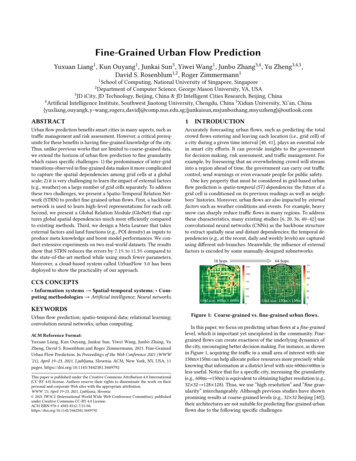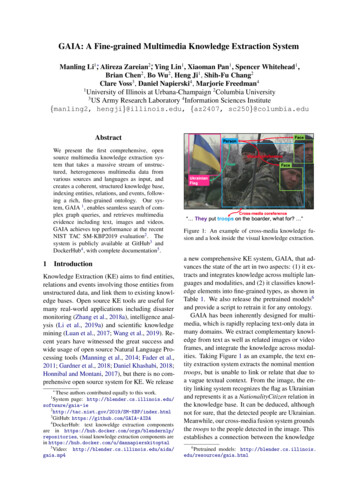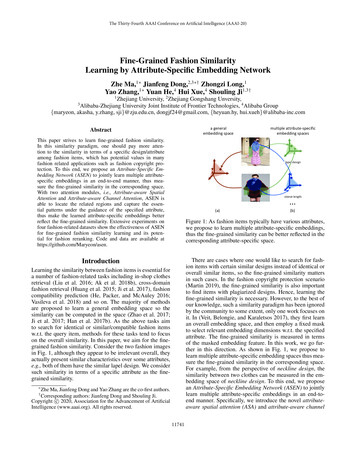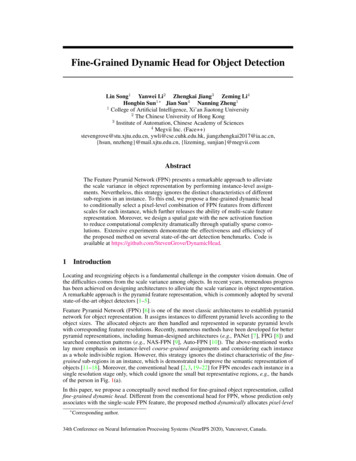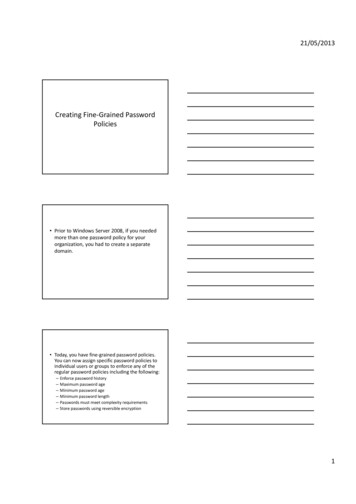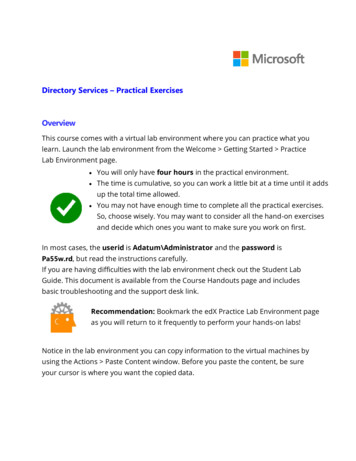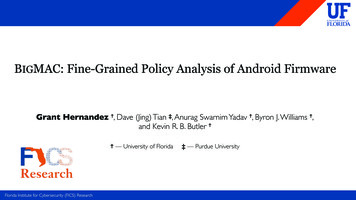
Transcription
Enforcing a fine-grained network policy inAndroidW.P. (Mark) van CuijkAugust 2011
ENFORCINGA FINE - GRAINED NETWORK POLICY INANDROIDMASTER THESISBYW.P. (MARK)VANCUIJKAUGUST 23, 2011SUPERVISORS:DR. IR. L.A.M. (BERRY) SCHOENMAKERSIR. M.B. (MAARTEN) NIEUWENHUISIR. M.B. (MATTHIEU) PÂQUES, CISA, CISSPEINDHOVEN UNIVERSITY OF TECHNOLOGYDEPARTMENT OF MATHEMATICS AND COMPUTER SCIENCE
AbstractTo prevent malicious applications from causing harm to the user of a device, the Android platform has a permission model. Applications are requiredto possess permissions when they want to perform operations that may incurmonetary cost or violate confidentiality and integrity of personal data storedon the device. One of the resources that has been protected by a permission isaccess to the Internet. In practice, 60% of the applications that are availablein the Android market request this permission, giving them access to communicate with any host on the Internet.This thesis presents the permission model used by Android and the wayit has been implemented. It also discusses several vulnerabilities that havebeen identified in existing research literature, including several proposals forenhancing the model. The contribution of this thesis is the proposal of an enhancement to the permission model that allows a more fine-grained Internetaccess policy to be enforced, implementing the principle of least privilege toInternet access by applications on the Android platform. A proof of concepthas been created to demonstrate the feasibility of the enhancement.
AcknowledgementsI would like to show my gratitude to my supervisor Berry Schoenmakers, especiallyfor helping me finding a suitable topic for this thesis and for giving constructivefeedback at times I was not sure about the directions to follow.This thesis would not have been possible without the help and support of mycolleagues at KPMG. In particular, I want to thank Maarten Nieuwenhuis andMatthieu Pâques for the time they have devoted to my project. Among otherthings, it has inspired me that, regardless of other work, you both took time during holidays, weekends and evening hours and even scheduled review blocks withhigh priority in your calendars.Other colleagues at KPMG I want to thank in special are Peter Kornelisse, ErwinHansen and Marjoleine Kruijf. You all have helped me a lot with getting started atKPMG. I also want to thank William Breuer for proofreading the entire thesis.Special thanks go out towards other Kerckhoffs Institute students graduatingat KPMG: Pieter Rogaar, Brinio Hond and Martijn Sprengers. In particular, I wantto thank Pieter for helping me to better understand the paper about SCanDroid.My education and this thesis would not have been possible without the supportof my parents and I want to thank them for their support over the years. Inparticular, I want to thank my mother for being helpful with putting things inperspective when making important decisions.Lastly, I offer my regards and blessings to all of those who supported me in anyrespect during the completion of the project.Mark van Cuijkiii
Table of ContentsAcknowledgementsiiiTable of ContentsvList of Figuresvii1 Introduction11.1Research question . . . . . . . . . . . . . . . . . . . . . . . . . . . . . . .21.2Subquestions . . . . . . . . . . . . . . . . . . . . . . . . . . . . . . . . . .21.3Thesis overview . . . . . . . . . . . . . . . . . . . . . . . . . . . . . . . .31.4Related work . . . . . . . . . . . . . . . . . . . . . . . . . . . . . . . . . .42 The Android permission model92.1Android architecture . . . . . . . . . . . . . . . . . . . . . . . . . . . . .2.2Applications . . . . . . . . . . . . . . . . . . . . . . . . . . . . . . . . . .112.3Android security model . . . . . . . . . . . . . . . . . . . . . . . . . . .122.4Conclusion . . . . . . . . . . . . . . . . . . . . . . . . . . . . . . . . . . .173 Implementation details of the permission model10193.1Inter-component communication . . . . . . . . . . . . . . . . . . . . .193.2Enforcing permissions . . . . . . . . . . . . . . . . . . . . . . . . . . . .223.3Conclusion . . . . . . . . . . . . . . . . . . . . . . . . . . . . . . . . . . .244 Known vulnerabilities of the permission model254.1Permission-free operations . . . . . . . . . . . . . . . . . . . . . . . . .254.2Permission-related shortcomings . . . . . . . . . . . . . . . . . . . . .274.3Executing applications . . . . . . . . . . . . . . . . . . . . . . . . . . . .314.4Conclusion . . . . . . . . . . . . . . . . . . . . . . . . . . . . . . . . . . .325 Existing improvements to the permission model335.1Changing permission granularity . . . . . . . . . . . . . . . . . . . . .335.2Kirin security policy invariants . . . . . . . . . . . . . . . . . . . . . . .34v
5.3Information flow analysis with SCanDroid . . . . . . . . . . . . . . . .365.4Apex permission model extensions . . . . . . . . . . . . . . . . . . . .415.5Discussion . . . . . . . . . . . . . . . . . . . . . . . . . . . . . . . . . . .425.6Conclusion . . . . . . . . . . . . . . . . . . . . . . . . . . . . . . . . . . .466 Improving the permission model: the introduction of fine-grainedInternet permissions476.1Constraining sockets . . . . . . . . . . . . . . . . . . . . . . . . . . . . .476.2Comparison of the potential solutions . . . . . . . . . . . . . . . . . .506.3Socket state machine . . . . . . . . . . . . . . . . . . . . . . . . . . . . .576.4Implementation details . . . . . . . . . . . . . . . . . . . . . . . . . . .596.5Socket policy . . . . . . . . . . . . . . . . . . . . . . . . . . . . . . . . . .646.6Conclusion . . . . . . . . . . . . . . . . . . . . . . . . . . . . . . . . . . .677 Conclusion and future work697.1Proof of concept . . . . . . . . . . . . . . . . . . . . . . . . . . . . . . . .697.2Conclusion . . . . . . . . . . . . . . . . . . . . . . . . . . . . . . . . . . .707.3Future work . . . . . . . . . . . . . . . . . . . . . . . . . . . . . . . . . .72Bibliography75Glossary79Index81
List of Figures1.1DroidWall configuration activity . . . . . . . . . . . . . . . . . . . . . . . .41.2Firewall iP prompting the user for network access . . . . . . . . . . . . .51.3BlackBerry prompting the user for network access . . . . . . . . . . . . .62.1System architecture of the Android platform . . . . . . . . . . . . . . . .92.2Sandboxing and component interaction . . . . . . . . . . . . . . . . . . .132.3Permissions screens for an application . . . . . . . . . . . . . . . . . . . .152.4Extension of content permissions . . . . . . . . . . . . . . . . . . . . . . .173.1Inter-process communication between Java objects . . . . . . . . . . . .203.2Permission checking when sending SMS . . . . . . . . . . . . . . . . . . .234.1Using vibrator settings as covert communication channel . . . . . . . . .265.1Example of SCanDroid flow policy violation . . . . . . . . . . . . . . . . .365.2SCanDroid flow extraction for single application . . . . . . . . . . . . . .385.3Combining SCanDroid application flows . . . . . . . . . . . . . . . . . . .406.1Policy enforcement moments . . . . . . . . . . . . . . . . . . . . . . . . . .516.2Linux socket state machine . . . . . . . . . . . . . . . . . . . . . . . . . . .576.3Socket classes . . . . . . . . . . . . . . . . . . . . . . . . . . . . . . . . . . .606.4Application accepting an incoming connection . . . . . . . . . . . . . . .627.1Application connecting to the Google homepage . . . . . . . . . . . . . .70vii
1IntroductionThe foundation for digital mobile phone technology as we know it today hasstarted in 1982, when the Confederation of European Posts and Telecommunications (CEPT) formed the Groupe Speciale Mobile (GSM) with the goal to designa pan-European mobile telephony technology [13]. By the year 2000, the firstcommercial General Packet Radio Service (GPRS) services were launched, allowing mobile devices to interact with the global internet using a packet switchedIP interface1 . Faster packet switched interfaces were introduced in the years thatfollowed.Alongside the evolution of GSM technology and ubiquitous mobile IP connectivity, device manufacturers succeeded in creating smaller, more powerful and lesspower-hungry processing and memory components. Also on the software side, advances were made, eventually allowing third-party applications to execute on thedevice hardware, creating the possibility for end users to extend the functionalityof a mobile device after purchase. According to most sources, this post-purchasesoftware installation capability is what differentiates a smartphone from ordinaryphones [1, 18, 29].One of the smartphone platforms that recently gained popularity is Android.Android was initially developed by Android, Inc., a company co-founded by AndyRubin and acquired by Google, Inc. in July 2005 [7]. The Android distribution andthe foundation of the Open Handset Alliance – a consortium of hardware manufacturers, software companies and telecom operators, publicly led by Google, Inc.– were announced in November 2007.Towards developers, Android is explained as a software stack for mobile devices that includes an operating system, middleware and key applications (see“What is Android?” in [2]).For security, Android employs a permission model that enables applications torequest permission to perform actions that may access private information, use1GPRS actually offers a wireless packet switched interface, capable of carrying any packet switchedprotocol, like IPX or X.25. Most operators only deploy IP over GPRS, since IP is used for accessing theWeb and carrying internet mail.1
the mobile network in ways the may incur a monetary cost to the user or mayotherwise cause harm. The model is based on a static set of permissions that anapplication states that it needs to function and the user can either choose to grantthose permission or abort the installation of an application.1.1Research questionHow can the permission model employed by the Android smartphone platform beimproved, such that some known weaknesses are fixed and the existing protectionand usability are preserved?1.2SubquestionsIn order to formulate an answer to the research question stated in Section 1.1,several subquestions have been formulated. These subquestions are constructedin such a way that these can be researched in an ordered fashion. The answersto those questions are given throughout this thesis and result in an answer to theresearch question.Q1. How is the current Android permission model designed?The current permission model used in Android has been designed to prevent applications from performing actions that the user doesn’t consent to. Examples ofresources that are protected by the permission model are access to stored textmessages and contacts, access to the internet and actions that incur a monetarycost to the user, like sending text messages or initiating phone calls. As a startingpoint, this subquestion aims to understand the currently implemented permissionmodel and is covered by Chapter 2.Q2. Which platform component(s) contribute to the implementationof the permission model?Given the design of the permission model, how is it implemented in the Androidplatform? The platform consists of a large number of components that fulfill functional and non-functional requirements, but most components don’t take an activerole in enforcing the permission requirements. For a thorough understanding, thissubquestion aims to provide an overview of the implementation components thattake part in implementing the permission enforcement requirements and is covered by Chapter 3.2
Q3. Which vulnerabilities are known to exist in the current model?In order to improve the permission model, it is required to have an overview ofthe vulnerabilities that must be addresses by the proposed improvements. Researchers found several weaknesses in the current permission model and thosehave been published in existing literature. This subquestion aims to identify theknown vulnerabilities and is covered by Chapter 4.Q4. Which improvements have already been developed?Existing literature already describes several improvements that can be implementedto enhance the current permission model. This subquestion aims to give an overviewof the existing improvements previously proposed by researchers and is coveredby Chapter 5.Q5. How can the permission model be improved to fix the identifiedvulnerabilities?By identifying the weaknesses that remain unresolved in existing literature, a listof necessary improvements has been formed. By enhancing the model, addressingthe known vulnerabilities, a final improved model can be designed, which will bethe main contribution of this thesis. This final model has been used to answerthe main research question defined in Section 1.1. This subquestion is covered byChapter 6.1.3Thesis overviewThis chapter finishes with an overview of related projects that will not be referenced later in this thesis, but that are relevant to this topic. Chapter 2 will presentthe Android application model and the way applications are secured against eachother. The implementation details of the intercomponent communication framework and the way permissions are enforced is presented in Chapter 3. Chapter4 presents some vulnerabilities that have been identified in existing research andChapter 5 presents some improvements that have been proposed to overcomesome of these vulnerabilities. The contribution of this thesis is presented in Chapter 6, which proposes a solution that allows a more fine-grained policy for Internetaccess to be enforced by the Android platform. Finally, Chapter 7 relates the proposed work to the research question and subquestions that have been posed inSections 1.1 and 1.2 and lists some topics for future research.3
Figure 1.1: DroidWall configuration activity that can be used by the user to selectwhat applications are allowed to communicate [20]1.4Related workThe security properties of the Android platform – as discussed in Section 2.3 – areonly scarcely documented and spread over several sources. Most information canbe found in the Android developers guide [2], but in any case, all documentation islimited to textual descriptions. Shin, et al. [22, 23] created a model that capturessome important elements of the permission model and have used the Coq2 proofassistant to prove certain security requirements they extracted from the Androiddocumentation. Although their model isn’t complete – e.g. they haven’t modeledthe fine-grained extension of content provider permissions – they already demonstrated their approach is capable of revealing flaws in the Android permissionmodel.1.4.1DroidWall for AndroidThe DroidWall [20] project for Android has managed to implement a user interface to the netfilter packet filtering subsystem that is part of the Linux kerneland follows the principle described in Section 6.1.2. As can be seen in Figure 1.1,DroidWall enables the user to enable or disable connectivity for individual appli2Coq is a formal proof management system that provides a formal language to write mathematicaldefinitions, executable algorithms and theorems.4
Figure 1.2: Firewall iP prompting the user for network access [14]cations and allows to define a different policy when connecting over Wi-Fi or aconnection to the mobile operator.Although technically possible, the DroidWall project does not allow the userto create a more fine-grained policy as will be possible with the implementedprotection proposed in Chapter 6.1.4.2Firewall iP for iPhoneCompared to Android, the iPhone platform introduced by Apple, Inc. has a different security model. On genuine iPhone devices, native applications can onlybe installed when they are published in the App Store. An extensive screeningprocedure is implemented to ensure no malicious application should be availablein the App Store.Native applications from other sources can only be installed after removing thetechnical limitations using a procedure known as “jailbreaking”. This procedureinvolves using vulnerabilities in the operating system in order to be able to replacesystem components without triggering other security controls.One of the applications that can be installed on a jailbroken iPhone is FirewalliP [19]. The application allows the user to create a fine-grained policy to restrictthe communication capabilities for applications. It can also request the user forpermission when an application requests a new connection that is unknown in thesecurity policy, as can be seen in Figure 1.2.No documentation is available that describes how Firewall iP enforces the policies, but the FAQ page of the Firewall iP website [19] reveals that a library with5
Figure 1.3: BlackBerry prompting the user for network access [10]the policy enforcing code is injected into the process of applications using MobileSubstrate [11]. MobileSubstrate allows developers to inject code into the address space of other applications to replace the existing implementation of specificclasses.Given the information available on the FAQ page of [19] and the functionalityoffered by MobileSubstrate, it can be assumed that the functionality of FirewalliP is implemented in a small library that is injected into other applications, suchthat it enforces a network policy when applications request establishing a newconnection.Under this assumption, it seems possible to bypass the protection mechanism.Because the code that is used to implement the policy enforcement resides in theaddress space of the application that it protects, the application is probably ableto either modify the code (by overwriting the code in memory) or bypass it byagain replacing the implementation of these classes with an implementation thatdirectly invokes the original code.1.4.3BlackBerry device firewallBlackBerry uses a permission system to allow users or the IT department of acorporate environment to determine what resources applications are allowed toaccess and what privileges they have to perform operations that may be harmfulto the user. This permission system closely resembles the one in Android, withthe main difference being that with BlackBerry the user is able to alter the setof permissions that is granted to an application, much the same as Apex makespossible with Android (see Section 5.4).For several permissions, BlackBerry allows to redirect the communication to abuilt-in firewall component, which enables the user or IT department to enforce amore fine-grained access policy (see Pages 337–340 of [15]). This built-in firewall6
can be used for internet communications, which contains three modes that canbe applied to an application: always allow, always deny or prompt, with promptbeing the default setting. When prompt mode is enabled, the system will freezean application that opens a connection to another host and request the user todecide whether or not to allow this connection request, as can be seen in Figure1.3.7
2The Android permission modelThe first step towards understanding and enhancing the Android permission modelis to see how what the general application model looks like and what security constructions have been implemented. This chapter will focus on the first subquestionof this thesis:Q1. How is the current Android permission model designed?Figure 2.1: System architecture of the Android platform [2]9
2.1Android architectureFigure 2.1 contains an architectural overview of the Android platform as it is published in the Android Developers Guide [2]. The components can be grouped infive classifications that make up the Android platform:The kernel is the lowest level in the architecture and is currently a standard Linux2.6 kernel. The kernel contains drivers to operate the hardware of the device and is responsible for supplying low-level functionalities like threadingand low-level memory management. One of the Android-specific components added to the Linux kernel is the Binder, which is used by the platformto facilitate communication between application components, see Section3.1.1.A set of C/C libraries is running on top of the kernel. Most of these librariesare existing open source libraries, tuned for execution on embedded Linuxbased systems.The Android Runtime contains the Dalvik Virtual Machine (see also Section 2.3.2),that implements a dialect of the Java Runtime Environment, allowing Android applications and the application framework to be implemented usingJava technology.The application framework provides the API (Application Programming Interface) that allows applications to interact with the device hardware and witheach other. Core applications shipped with Android, like SMS and contactapplications, use the same framework API that is available to third partydevelopers, allowing all developers to build powerful and integrated applications.Applications run on top of the application framework and are mostly written inJava. Section 2.2 further describes what components make up an Androidapplication.The remainder of this thesis mainly focuses on the Binder kernel driver, theDalvik virtual machine, some application framework components and the applications compartment, since these are specific to Android. The other components arerather common in Linux-based systems – including servers and desktop computers– and are therefore out of the scope of this thesis.10
2.2ApplicationsAndroid applications are mostly written in Java1 and are built up using components that can be of four types: activities, services, broadcast receivers and contentproviders [2, 4, 9]. To explain these component types, an example application isused that can track the location of friends and notify other applications aboutfriends that are nearby.Activities are the fundamental concept that allows interaction with the user. Atany point in time, a single activity is visible on the screen. A simple application might have only a single activity, while more complex applicationsconsist of several activities that, together, form a user interaction model.Normally, an activity is started at the moment that it needs to interact withthe user and it is stopped as soon as it is not visible on the screen anymore.The example application might contain an activity that displays all friendsin a list, maybe including their current location. Another activity in this application can be a settings screen, allowing the user to modify the behaviorof the application. Yet another activity can be a form to add a new friend tothe application.Services are components that are not visible to the user, i.e. that don’t have auser interface. The lifetime of a service is therefore not automatically linkedto the visibility of user interface elements, but controlled by the operatingsystem in response to the need of the service and available resources. Applications can bind to a service that is already running in order to communicatewith them. When a service isn’t already running when an application bindsto it, the Android platform will start up the service.In the example application, the component that receives location information about friends and updates this location in the local storage and/or informs other application about friends getting nearby or farther away is aservice. It runs in the background and doesn’t interact with the user itself.Broadcast receivers also don’t have a user interface, but are designed to react toevents, such as a change in timezone or a battery running low. Broadcastscan be sent by both the platform and components or third party. Broadcastreceivers may bind to services in order to start an operation after receivinga broadcast or may start an activity to initiate interaction with the user.Again using the above example, a broadcast receiver can be a component ina third party application that will be informed when the location of friends1The Native Development Kit (NDK) allows Android applications to be written partly or entirelyin a lower level language, enabling applications that have higher performance requirements than canbe offered when running code in a virtual machine.11
changes. When the service notices this event, it sends a broadcast, whichwill trigger the broadcast receiver.Content providers provide an interface to applications to access data providedby the content provider application. Often, a content provider uses the filesystem or an SQLite database to store the data, but any method that’s appropriate for the type of data is acceptable.The example application needs to store the tracking details and current location of friends. This information is probably stored in a database. To giveother components in the example application – or even components in thirdparty applications – access to this information, a content provider can beused.When one of the components of an application needs to run and the application is not already started, a Linux process running the Dalvik VM is created andthe component will run in this process. By default, all components of a singleapplication run in this process, but any application is free to start new processesand run arbitrary Java and non-Java code.2.3Android security modelAndroid incorporates several mechanisms to prevent applications to adversely affect each other’s operations [2, 4]. By running applications in a sandbox, the onlyway for two applications to communicate is through explicitly shared resources.Access to those shared resources is guarded by a permission model. Applicationsdon’t have access to any resource by default, all required permissions must berequested at install time.2.3.1Application sandboxThe application sandbox is implemented in Android by running each applicationin an individual Linux process and allocating a unique user ID for each application.The Linux kernel manages access to files and other objects in the file system usingthe standard access control procedures used in UNIX systems2 . As a result of this,files created by one application are not readable by other applications.One exception to this general rule exists: two applications that are createdby the same developer can request a shared user ID. The requirement that theapplications are created by the same developer prevents malicious developers to2In UNIX, for every object in the file system, an owner, a group and a file mode is stored. The filemode contains permissions bits, specifying read, write and execute access permission for the principles“owner”, “group” and “other” [27].12
Binderuid 1000uid 1001Interaction betweenapps with same user IDuid 1001No interactionacross user IDsuid 1002Interaction throughbinder interfaceFigure 2.2: An example of a set of four installed applications in a sandboxed environment. Two applications created by a single developer have requested to sharea user ID and are therefore able to exchange information using the file system.Arrows indicate interaction paths; the direct interaction between the applicationwith uid 1002 and an application with uid 1001 is not possible. The only way forthe other applications to communicate with components outside of the sandbox isby using the binder interface (see Section 3.1).circumvent the permission system by requesting a shared user ID with a sensitiveapplication. To ensure that the applications are created by the same developer,Android verifies that both applications are signed using the same certificate.Application components running in different Linux processes are able to communicate by using a standardized inter-component communication framework.The ICC framework employed by Android builds upon the OpenBinder framework[17]. A more technical description of the binder framework can be found in Section 3.1. Figure 2.2 shows how applications are able to interact using the binderframework.2.3.2The role of the Dalvik VMOne of the main requirements of the Dalvik VM is to execute bytecode under thestringent memory requirements imposed by embedded systems; this has thereforebeen one of its main design goals [6]. The bytecode that Dalvik operates on isnot identical to standard Java bytecode and therefore the Dalvik .dex file formatis incompatible with standard Java .class files. The Android SDK includes the dxtool [2], that allows developers to convert .class files to .dex files.While it may be tempting to assume that Dalvik acts as a security sandbox, thisisn’t actually the case. Quoted from the “Security and Permissions” sections of theAndroid Developers Guide [2]:13
The kernel is solely responsible for sandboxing applications from eachother. In particular the Dalvik VM is not a security boundary, andany app can run native code (see the Android NDK3 ). All types ofapplications — Java, native, and hybrid — are sandboxed in the sameway and have the same degree of security from each other.Despite Dalvik not being a security mechanism, relying on the Java programming language for application development enforces type-safety and preventscommon riskful programming mistakes, like buffer overflows, memory leaks anddecreases the possibility of remote code execution in general. Since applicationsmay use non-Java code, it should be noted that these programming errors canstill occur in Android applications. Vulnerabilities might also exist in the C/C system libraries and those might be exposed through official API’s towards Javaapplications.2.3.3Declarative permission modelBesides user ID sharing, several communication mechanisms are available for applications that need to interact. These mechanisms are defined by the Androidplatform and are protected by a permission checking system. The permissionsthat an application needs are declared in a manifest file, which is part of the application package. Examples of permissions defined by Android are the INTERNET4and the SEND SMS permissions.During installation of the application, Android informs the user about the declared permissions, such that the user can decide w
ter 6, which proposes a solution that allows a more fine-grained policy for Internet access to be enforced by the Android platform. Finally, Chapter 7 relates the pro-posed work to the research question and subquestions that have been posed in Sections 1.1 and 1.2 and lists some topics for future research. 3
